Porcelain Insulator News
by Jack H. Tod
Reprinted from "INSULATORS - Crown Jewels of the Wire", December 1975, page 24
Emma Almeida (One Bay View Dr., Shrewsbury, MA 01545) just reported finding
what seems to me to rate as the classic of all classics. The preliminary drawing
of this Imperial pin type shown here is from a very good sketch and measured
dimensions sent by Emma.
First of all, this is a first report of this general style by Imperial. To
top that, it also is a light brown glaze -- much rarer than white for any
Imperial item.
The insulator has rainwater drain ridges on the skirt and a very extended
petticoat -- both features of the Ralph D. Mershon patent #605,256 of June 7,
1898. (see also the "MERSHON TYPE" in last month's column.)
It also has four equally spaced strengthening ribs under the skirt as shown.
These are claimed in the patent #700,463 of May 20, 1902 by William J. Walther,
Boston Mass. Note that this date agrees with the fact that Imperial made some
items with brown glaze only in the later part of their pin type manufacture
(1902-1904).
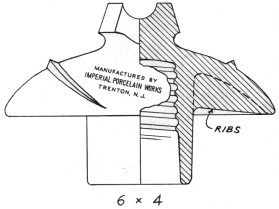
Next, note the large 1-5/8" threaded pin hole. This large pin evolved
from the second series of insulators designed for the Niagara power line and is
known only for such insulators as the Thomas "Niagara 'E'" and a few
special Lockes in the early 1900's. It is interesting to note that Thomas also
once cataloged a design with a 1- 7/8" pin hole, and Locke cataloged a
cable type in 1910 which had a 1-15/16" pin. This information isn't really
pertinent, but I've had these answers for a long time and no one has ever asked
the questions!
Glass insulators somewhat similar to this specimen are known and are
connected with C. S. Knowles Co., a jobber of electrical supplies in Boston,
Mass. It is also fact that Knowles was a major distributor of the Imperial line
of porcelain insulators in the early 1900's. It is possible that inventor
Walther (the support ribs) had a position with C. S. Knowles Co., both being in
Boston.
Putting all these facts together, it is interesting to speculate that
Imperial did not create this design as a proprietary item, but rather
manufactured it to the dictate of C. S. Knowles Co. Whereas the comparable
styles in glass insulators (by Brookfield) sold by Knowles are relatively
common, this porcelain version by Imperial is unique (thus far) and may have
been in the nature of an experimental item made only briefly or in limited
numbers. It is also possible the design evolved at about the time Imperial
ceased manufacturing pin types (estimated 1904); the 1909 patent involved plus
the 1- 5/8" threads as first cataloged by Thomas in 1904 (the Niagara
"E". U-966).
This one specimen not only seems to answer a number of important questions
about both Imperial and C. S. Knowles, but it is an outstanding museum piece
because of it being the only known porcelain with either the mid- skirt rain
ridges or the interior support ribs.
I hesitate to comment on the possible monetary value of unique and infinitely
desirable classics, but let's have a go at it. An Imperial with clear marking is
good for a $15 starter, and the rare brown glaze raises the ante maybe $50 more.
The 1-5/8" pin hole on Imperial should chip in maybe another $50. The rain
ridges and interior support ribs (both unique on porcelains) are worth $150 to
$200 each. The firm C. S. Knowles connection an intangible $??. And all this on
one insulator -- a unique one at that, Let's see, what are we up to so far....
Jack

If you have an open-end guy strain (either eggs or boxy types) with the
Circle-P marking shown here, it was made by Pittsburg. Jerry Turner (Ohio) and I
dug some of these from Pittsburg factory dumpage near Derry, Pa. last year.
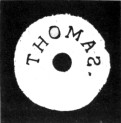
Dear Mr. Tod:
I have been collecting porcelain insulators for about two years and have in
my collection about 200 different ones (ponies, cables, signals, wire holders,
spools and odds & ends). I have several items that I would like you to help
me with information on, and I am sending sketches, print copies and foil
impressions of markings on these items.
One is a small knob (standard #11, marking on above photo retouched) white in
color. The THOMAS is embossed on one end with the S backwards.
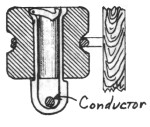
Another is a white knob 2-3/4" diameter and 2-3/8", tall. It has a
rectangular hole and a removable metal clamp device that fits into this hole.
The heavy and distinct embossing on the end is G. E. CO. U.S.A. plus PAT. JAN.
29. 1901 .
Any information you can tell me about them I would appreciate.
Laura Linscott
(age 7)
Titusville, Florida
- - - - - - - - - -
Dear Laura:
From the several items you describe, you must certainly have a fine
collection, and the above two items are real "goodies".
I have seen the THOMAS embossed marking on jillions of porcelain insulators
of countless types of all vintages, but have never seen one with this backward S
error (all letters are serif type, including backward S). This has to rate as a
very interesting error for a company so consistent in their markings on
insulators.
The second knob with metal clip is part of a patented "tieless
knob" an I've sketched above. The patent is #667,103 of Jan 29, 1901,
Howard R. Sargent, Schenectady, N.Y., assignor to G. E. Co. After pressing the
loop up into the knob, the top hook is closed downward to prevent the loop from
falling out. The notch in the hook in for disassembling it.
In practice, the knob is screwed into a mounting wall, and a running wire can
be hung without stringing through an ordinary slack wire insulator such as
wireholders. There are many simpler forms of slack wire tieless knobs, and this
one seem overly complicated for the purpose. But in 1901 anything novel was a
seller if not impractical.
Needless to say, any of these patented knobs unusual in design are good
collector items, and all these earlier ones appear to be rare or very rare.
Jack
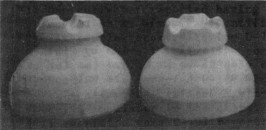
Dear Jack:
I'm sending this photo since most collectors have probably not seen the early
Fred M. Locke cross-top with the embossed (raised) marking in the top cross
grooves.
The insulator on the left is U-923C with the rare embossed marking (Ref No.
2-1) in the grooves. Several specimens of this have been located in California
in the past few years.
The insulator on the right in U-923A and has the incuse handstamp marking (#
2- 2) in the cross grooves. This is the marking type on the relatively common
U-923 style.
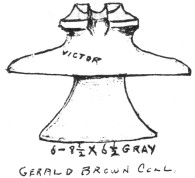
Also enclosed is a sketch of a very interesting Locke multipart with the
VICTOR trademark marking (circa 1901-1910). This insulator has a very beautiful
gray glaze.
(This is Locke catalog number 405A, rated 27 Kv, style circa 1908 and later,
thus dating the specimen about 1908-1910. J.T.)
Gerald Brown
Two Buttes, Colo.

Ed Smith (Union Springs, N.Y.) advised in the July collector survey that he
has a mint U-339. He traded for it at the Scotia show a couple of years ago.
This style was made by Pittsburg, and Ed's specimen is unique (as far as I
know) in mint condition. The only previously know specimens were badly broken
ones rescued from Pittsburg plant dumpage.
Ed also reported having a U-294A with the embossed THOMAS marking on the
skirt, and in white glaze. That's the first one of these in white I have heard
of.

The U-141 in the porcelain style chart is a very special insulator. This is
the very first wet process pin type ever made, and it was cataloged by Pass
& Seymour in 1892 (see page 179 of Porcelain Insulators Guide Book).
The outer shell is of porcelain made by the casting process. A metal thimble
is held in place with a porous cement filled with paraffin wax. The entire
design is Covered by patent 476,813 of June 14, 1892, James Pass and Albert P.
Seymour, Syracuse, N. Y.
If a specimen of this ever did show up, it would be a true museum piece on
several counts, but to date I have never seen one or heard of anyone having one.
I've had several people report having a U-141 and have seen it listed on
trade or sell lists, but each time I have checked it out and the insulator was
just an ordinary beehive style that approximated the U-141 shape and size. In
the July collector survey, 4 people listed it as in their collections and even
though I haven't checked these reports yet, I'm just assuming none of these are
the true U-141 unless someone yells to correct me that they do actually have the
above described P & S insulator.
Since the U-141 is currently an unknown style (and obviously would be
valuable if found), it would behoove us not to cloud up the picture by listing
common porcelain beehives as U-141 on trade lists. And if anyone ever does turn
up a U-141, please yell loud so we'll know about it.
The tabulated nose count of unknown rare or prized U- number styles (July
collector survey) loses much of its punch because less than 40 people checked
their insulators against the list. We did not receive reports from many people
with large collections. I have seen specimens in some collections for which none
to only a couple are shown in the following tabulation.
Nevertheless, here are the results, and they may be of some interest to you.
The parenthetical numbers such as (*1) refer to notes following the list. The
other numbers indicate the number of collectors having that U- number.
| U- |
Number of People |
U- |
# People |
U- |
# People |
U- |
# People |
U- |
# People |
|
25
|
1
|
191
|
9
|
330
|
(*1)
|
412A
|
|
818A |
|
|
35
|
2
|
191A
|
12
|
334
|
11
|
412B
|
|
822 |
2 |
|
43
|
4
|
192
|
10
|
334A
|
3
|
414
|
3
|
862
|
|
|
59
|
3
|
192A
|
10
|
335
|
6
|
416
|
5
|
863
|
|
|
67
|
3
|
193
|
10
|
338
|
7
|
419
|
2
|
864
|
2
|
|
68
|
8
|
194
|
5
|
337
|
|
419A
|
1
|
922
|
2
|
|
70
|
9
|
195
|
7
|
339
|
1
|
421
|
4
|
923
|
8
|
|
71
|
|
197
|
7
|
339A
|
|
435
|
|
923A
|
9
|
|
76
|
9
|
197A
|
2
|
363
|
|
436
|
1
|
923B
|
3
|
|
81
|
6
|
198
|
2
|
364
|
|
437A
|
|
923C
|
4
|
|
82
|
(*1)
|
199
|
11
|
365
|
3
|
437B
|
|
923D
|
1
|
|
83
|
(*6)
|
199A
|
2
|
366
|
|
441
|
3
|
924
|
1
|
| 84 |
(*5) |
200
|
1
|
367
|
|
494
|
|
925 |
12 |
|
85
|
3
|
200A
|
3
|
368
|
5
|
514
|
1
|
927
|
4
|
|
89
|
5
|
201
|
10
|
370(*1) |
|
520
|
|
927A |
2 |
|
90
|
9
|
201A
|
6
|
373(*1)
|
|
535
|
|
927B |
2 |
|
91
|
2
|
201B
|
2
|
375
|
|
535A
|
|
927C |
6 |
|
93
|
3
|
202
|
11
|
376A
|
|
541
|
3
|
928
|
9 |
|
94
|
8
|
202A
|
12
|
380
|
3
|
590
|
(*1)
|
928A
|
3
|
|
97
|
4
|
205
|
7
|
382
|
1
|
591
|
2
|
929
|
3
|
|
98
|
5
|
206
|
9
|
389
|
|
592
|
-
|
933
|
3
|
|
98A
|
3
|
206A
|
6
|
390
|
11
|
593
|
-
|
934
|
5
|
|
98B
|
1
|
207
|
10
|
393
|
10
|
595
|
3
|
935
|
9
|
|
100
|
|
207A:
|
12
|
393A
|
9
|
639
|
6
|
935A
|
3
|
|
109
|
(*2)
|
207B
|
4
|
394
|
|
675
|
7 |
936 |
4 |
|
110
|
9
|
207C
|
3
|
395
|
12
|
694
|
1
|
937
|
5 |
|
126
|
|
297D
|
5
|
396
|
2
|
695
|
4
|
939
|
1 |
|
128
|
6
|
208
|
6
|
397
|
4
|
697
|
|
939A
|
|
|
134
|
7
|
208A
|
7
|
398
|
8
|
697A
|
1
|
939B
|
2 |
|
141
|
(*3)
|
209
|
8
|
399C
|
2
|
699
|
3
|
939C
|
|
|
146
|
|
210
|
5
|
399D
|
|
701
|
3
|
940
|
2 |
|
157
|
3
|
211
|
5
|
400
|
3
|
712
|
-
|
944
|
6 |
|
160
|
7
|
212
|
1
|
400A
|
1
|
744
|
9
|
949
|
2 |
|
166
|
2
|
213
|
4
|
401
|
1
|
779
|
4
|
954
|
1 |
|
173
|
4
|
215
|
2
|
401A
|
|
807
|
2
|
954A
|
|
|
174
|
9
|
216
|
|
402
|
6
|
807A
|
|
955
|
1 |
|
182
|
1
|
217
|
6
|
404
|
|
808
|
|
966
|
4 |
|
183
|
7
|
217A
|
10
|
405
|
|
810
|
|
970 |
1 |
|
184
|
10
|
220
|
7
|
406
|
|
811
|
|
974
|
1 |
|
185
|
|
223
|
3
|
407
|
2
|
813
|
|
979
|
2 |
|
186
|
9
|
224
|
1
|
408
|
4
|
814
|
|
980
|
2 |
|
187
|
5
|
225
|
4
|
410
|
2
|
816
|
1
|
981
|
3 |
|
189
|
3
|
252
|
|
410A
|
|
816A
|
|
982 |
|
|
189A
|
3
|
254
|
|
411
|
|
816B
|
3
|
985
|
1 |
|
189B
|
3
|
259
|
3
|
412
|
|
818
|
|
986 |
|
Notes on the preceding tabulation:
(*1) One collector reported having this style, but I suspicion an error in
identification or listing.
(*2) Six people reported having U-109, but I'm presuming they have the
similar, common U-108 not in the survey list. I know of only one U-109 specimen.
(*3) Four people reported U-141, but I'll leave it zero unless someone confirms
having the actual P & S U-141 insulator in the chart.
(*4) I suspicion some U-197 reported are actually the U-197A. They differ
only in the glazewelding method. (See drawings in the style chart).
(*5) Seven people reported U-184, but I think some of these are probably the
U-185 which is similar.
(*6) My goof. The U-83 is an unassigned number. Sorry 'bout dat.
There weren't too many surprises in the tabulation of styles -- but there were
a couple. Note that a second U-407 Jumbo surfaced. There were also several with
two or three specimens reported and which were previously in the one-only class
(as far as I knew).
All of the transposition styles were included in the list, since these are so
widely collected. Since there are at least a dozen large collections and tramp
specialists represented here, you can readily see some of the styles which are
tough to come by. Note that ones like U-198, 212 and 216 are really TUF as
compared with the romanticized MACOMB U-197 and U-197A. The U-100 duplex
transposition is also on the TUF list, and none have been reported since the
initial discovery specimen two years ago.
Also note that the big collections reporting do have the patent-tops such as
U-183, 184, 186, 187, but no one reporting had the U-185 and only one has the
U-182.
The tabulation also shows that collectors tend to have more interest in
exotic shapes and early classics than in more ordinary styles, regardless of
rarity.
Robert Winkler (Indiana) sent the excellent drawing of a South Shore line
truck for this mouth's Porcelain Corner. I checked it over with a 4-power
magnifier for any error in detail, but couldn't find one!
| 